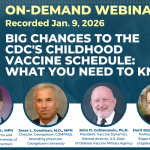By Courtney Wise Randolph, American Cities Fellow
Drawing from decades of on-the-job expertise, a panel of health and science journalists led a discussion of best practices for finding sources on deadline.
Liz Szabo, an independent journalist; Mary Chris Jaklevic, AHCJ patient safety health beat leader; and Lauren J. Young, associate editor for health and medicine at Scientific American offered a hefty tip sheet and set of slides curated from their many years of experience. They also provided tried and true methods for connecting to sources on social media – including Reddit and TikTok, both of which may be overlooked due to assumptions about validity.
As expected, the speakers directed reporters right to where you’re reading this right now: the Internet. Tried and true websites include the NIH’s PubMed and Google Scholar – with the caveat that Google’s AI applies the term “scholar” loosely.
A less known resource is Inspire.com, suggested by a session attendee. Unlike PubMed and Google Scholar, which return research papers authored by experts in science, Inspire is an online community of average citizens sharing their lived experiences with visible and invisible health conditions. Members tend to find their way to Inspire through patient advocacy groups seeking to direct them to other avenues of support, according to the Inspire website.
But, the might of the tip sheet cannot be understated, particularly for early- to mid-career journalists. Besides the aforementioned sites, it lists newsletters produced by underrepresented voices, books, academic journals, and suggestions for affinity groups and hashtags that can direct you to the source your story still needs.
For investigative work, knowing how your sources are funded is critical. ClinicalTrials.gov, Dollars for Docs from ProPublica, and PharmedOut.org are helpful databases to run a search. Funding from pharma doesn’t warrant an automatic exclusion from your story, but it does require full disclosure.
But reporter, beware! While you may know that pharmaceutical companies contribute funding to nonprofits and researchers, you may be surprised to learn that some patients are funded by pharma too. “Astroturf groups,” as they’re called, are patient groups that are fully curated by pharmaceutical companies to help sell a drug, Szabo said. She referenced the patient group created by the makers of a medication being marketed as the “female Viagra,” as an example.
The speakers also offered tips on establishing trust with potential sources in social media groups. While we tend to search online communities for stories, the people in them tend to be wary of talking to journalists. This distrust can be mitigated by being clear about your purpose and reaching out to moderators of online groups before joining them. This gives the people managing groups an opportunity to inform existing members of what they should expect from you.
As a matter of process, once you’ve secured a source, over-explain what they can expect from working with you – and do so repeatedly, the panel said. And always, thank them for their help explicitly by giving them a copy of your finished work. None of us can do it without them.
Courtney Wise Randolph is an independent journalist based in Detroit, Michigan. She was a 2024 AHCJ American Cities Fellow.




